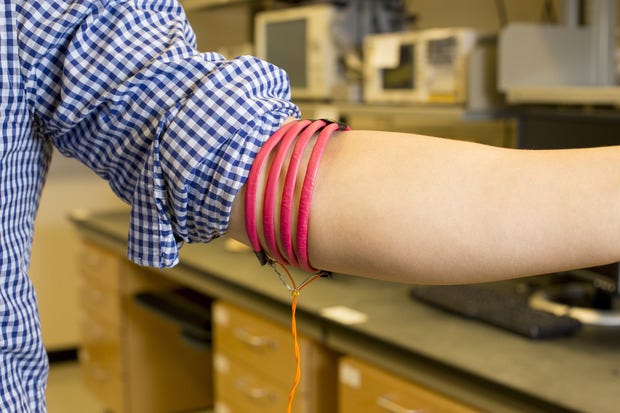September 9, 2015
Last month, researchers released a prototype for a new wireless communication technique that sends magnetic signals through the human body, leveraging its natural magnetic waves. The technology could offer a more secure way to communicate information between wearable electronic devices.
Jordan Brandes
|
Jiwoong Park, a grad student in UCSD professor's Patrick Mercier lab, shows off a magnetic coil that treats the human body as a network. Image courtesy of UC San Diego. |
Though it is still in the proof-of-concept phase, electrical engineers at the University of California, San Diego are working to develop an ultra-low power wireless system that uses the human body itself as a network for full-body health monitoring. "In the future, people are going to be wearing more electronics, such as smart watches, fitness trackers, and health monitors. All of these devices will need to communicate information to each other," explains professor Patrick Mercier of the department of electrical and computer engineering at UC San Diego, who led the study.
A prototype was built to demonstrate the technique. The unit consists of copper wires insulated with PVC tubes. On one end, the copper wires are hooked up to an external analyzer. On the other end, the wires are wrapped in coils around three areas of the body: the head, arms, and legs. These coils serve as sources for magnetic fields and are able to send magnetic signals from one part of the body to another using the body as a guide.
Beyond just simple interaction through the body, the study presents a solution to some of the key barriers of other wireless communication systems. For instance, in order to reduce power consumption when transmitting and receiving data, wireless systems need to send signals that can travel from one side of the human body to another. Bluetooth technology uses electromagnetic radiation to transmit data but these signals do not easily pass through the human body and require a boost of power to help overcome signal obstruction, also known as "path loss."
By using the body itself as the medium to deliver magnetic energy between electronic devices magnetic fields pass freely through biological tissue allowing signals to communicate with much lower path losses and, potentially, much lower power consumption. Researchers showed that the path losses associated with magnetic field human body communication are upwards of 10 million times lower than those associated with Bluetooth radios.
More importantly, the prototype does not pose any serious health risks. The technique was intended for applications in ultra-low power communication systems where the transmitting power of magnetic signals sent through the body is many times lower than that of MRI scanners and wireless implant devices.
Though the method can be used with wearable medical devices, professor Mercier notes that the researchers did not have any specific device in mind when the prototype was created although "something like an EEG headset communicating to a smartwatch would be a good example."
Since this is only a prototype of the technique one must wonder what Professor Mercier and his engineers consider the next step. Medical device implants, for instance, are becoming a hot topic in the industry. "We have not done experiments to implants, so we cannot say for sure right now," notes Professor Mercier "It looks promising, though."
One limitation of the method is that magnetic fields require circular geometries in order to propagate through the human body. Devices like smart watches, headbands, and belts will all work well using magnetic field human body communication but not a small patch that is stuck and the chest and used to measure heart rate. As long the wearable application can wrap around a part of the body it should work with the human body communication technique, explained researchers. Whether or not the prototype would work with other geometries is inconclusive at the moment. "It is hard to say, we have not done any experiments with other geometries yet," notes professor Mercier.
Learn more about cutting-edge medical devices at MD&M Philadelphia, October 7-8, 2015. |
Jordan Brandes is a contributor to Qmed.
Like what you're reading? Subscribe to our daily e-newsletter.
About the Author(s)
You May Also Like



